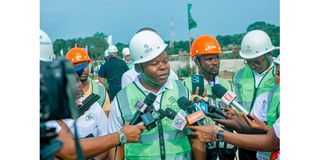Reasons for water shortages for residents served by the Upper Ruvu

What you need to know:
- The establishment of industries in the Coast region, particularly around the Mlandizi area, has contributed to water supply levels failing to meet demand, resulting in shortages
Moro/Dar. The Dar es Salaam Water Supply and Sanitation Authority (Dawasa) has revealed that the increase in industrial and residential activities in the Coast region is the primary reason why residents served by the Upper Ruvu plant often experience water shortages.
In contrast, those served by the Lower Ruvu plant face fewer challenges, as the area is large but sparsely populated.
“The establishment of industries in the Coast region, particularly around the Mlandizi area, has contributed to water supply levels failing to meet demand, resulting in shortages in these areas.
The authority is currently implementing both long-term and short-term measures,” said the authority's acting director general, Mr Mkama Bwire.
He made these remarks on Friday, February 7, during a visit by journalists to the Kidunda Dam and Bangulo projects, located in the Morogoro and Dar es Salaam regions; the projects aim to address the water shortage issue in both the short and long terms.
Mr Bwire further explained that the Upper Ruvu plant currently has the capacity to pump 190 million litres of water per day, but it is still not enough.
To address the challenge and ensure reliable water distribution to residents in the affected areas, authorities plan to add two new pumps this month to the Bangulo project in Pugu, which has built wells to reserve water.
“These additions will improve water distribution efficiency and reach a larger number of citizens. This area has a large population but a small geographical size, so the water supply project will help increase distribution and solve the challenge,” he said.
The Bangulo project, which costs Sh36 billion, is nearing completion and will be officially opened this month.
The project will serve over 450,000 residents in the Mzinga, Kipunguni, Kitunda, Pugu Station and Kiluvya wards; Msigani and Kinyerezi wards will also benefit from improved water pressure.
The Kidunda project in Morogoro, designed to address severe water shortages during droughts, particularly in September and November, has now surpassed 27 percent completion.
The project, which had been on the drawing board since 1961, officially began last year and will cost the government Sh336 billion.
It is set to be completed by June 2026 and is managed by Dawasa under the Ministry of Water.
“This dam is connected to the Ruvu River, which is the main source of water for the Coast and Dar es Salaam regions, providing more than 87 percent of all the water produced in this service area,” he said.
Mr Bwire added that the availability of water services has been affected by recurring challenges, including decreasing water levels in the Ruvu River due to weather-related issues.
The main purpose of constructing the dam, which will have a capacity to store 190 billion litres of water, is to ensure a consistent water supply to Dar es Salaam and the Coast regions, even during drought periods.
In addition to water storage, the dam will also produce 20 megawatts of electricity, which will be connected to the national grid. Residents near the project will also be able to engage in fishing and other activities.
For his part, the chairman of the Tanzania Editors' Forum (TEF), Deodatus Balile, said the construction of the dam marks a new chapter in the availability of this essential service for both industrial and domestic use.
“The media reported that the solution to this crisis was the construction of a dam, and today we are witnessing its progress.”





